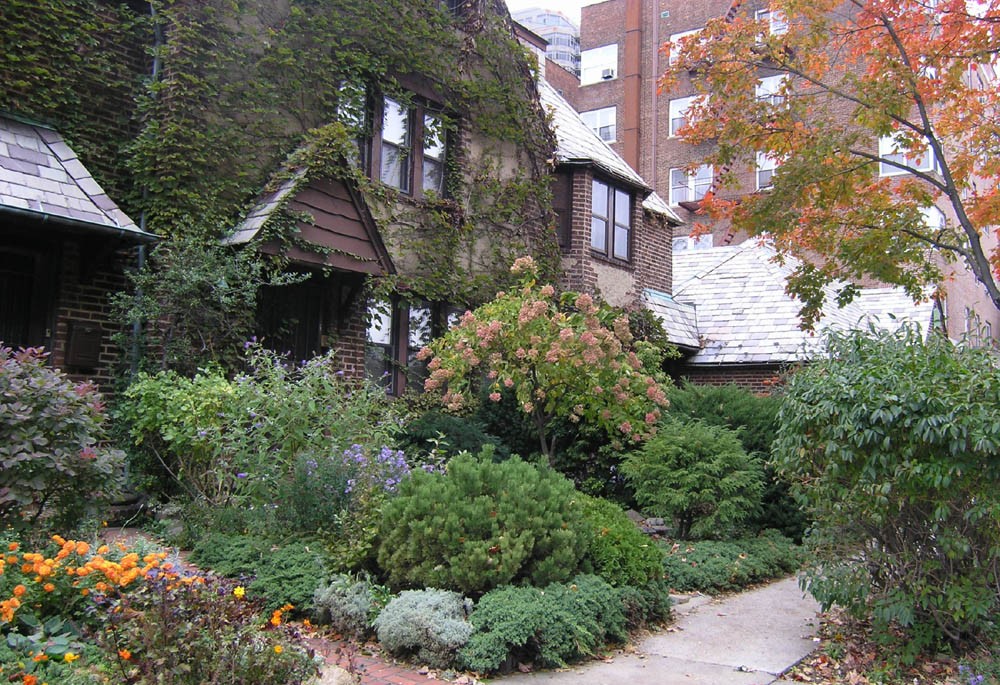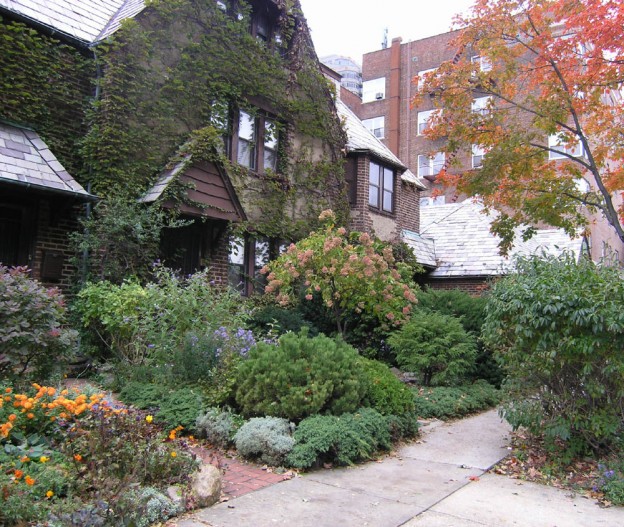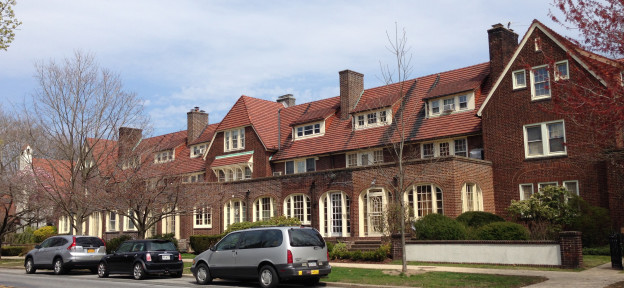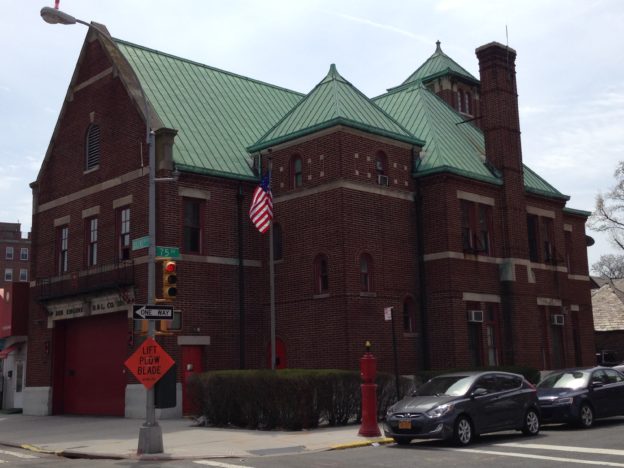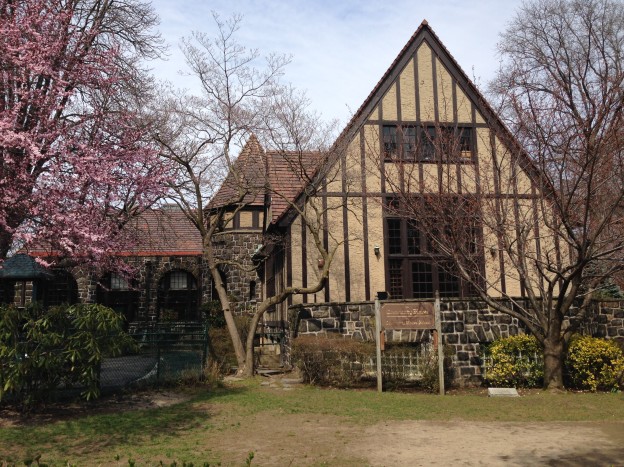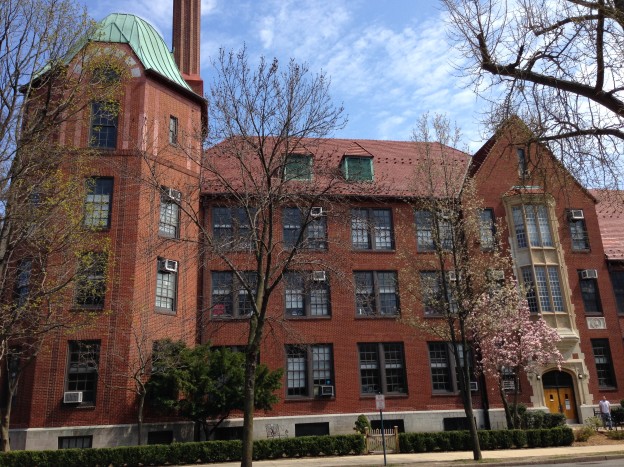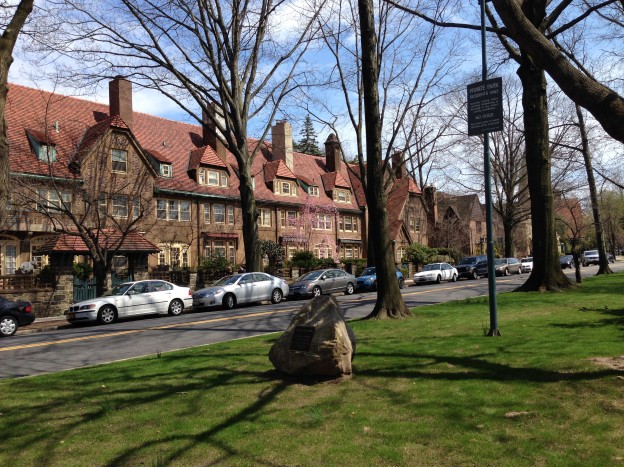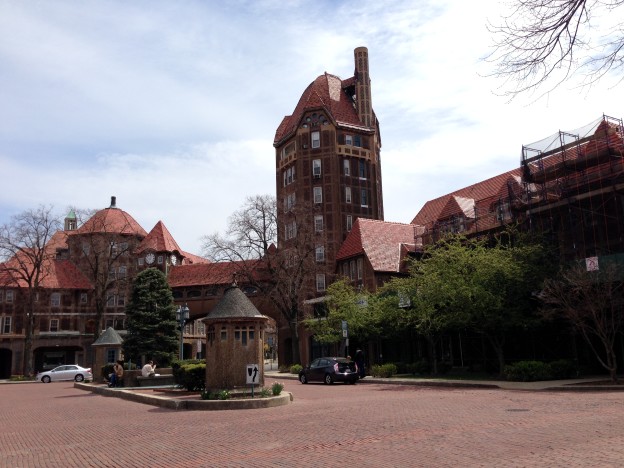One of the first Queens residential developments was Forest Hills, a 600-acre parcel of farmland previously known as the Hopedale section of Whitepot. Purchased by the Cord Meyer Development Company in 1906, the parcel was renamed in honor of its proximity to Forest Park and its elevation above the surrounding area.
For this new development, George C. Meyer stipulated the layout of a suburban community, with lots designated for houses, schools and churches, as well as utilities and plantings. Aesthetically, the area would be united by its architecture. Meyer hired architects Robert Tappan and William Patterson to design single-family houses that would complement one another. Cord Meyer began the development of these lots in 1906, mostly north of Queens Boulevard. Forest Hills Gardens was established in 1909, and the community was completed in 1912-13. Arbor Close and Forest Close, small townhouse complexes with shared gardens, were constructed in 1925 and 1927, respectively.
To learn more about Forest Close & Forest Hills click here
Grosvenor Atterbury and Frederick Law Olmsted, Jr.,;
1912-13|
One of the earliest planned garden communities in the country, Forest Hills Gardens was inspired by urban theorist Sir Ebenezer Howard’s Garden City Movement, which originated in England in 1898. The movement emphasized the confluence of natural surroundings within urban residential environments. It is believed that Forest Hills Gardens was specifically modeled after Hampstead Garden Suburb on the outskirts of London. The community’s winding tree-lined streets, English-inspired streetlamps and graceful architecture are the work of architect Grosvenor Atterbury and landscape architect Frederick Law Olmsted, Jr. Atterbury grew up in Long Island, studied architecture in New York and Paris, and in his early career apprenticed at the firm of McKim, Mead & White, specializing in summer homes and country estates. He was also interested in architecture for the working poor, designing a model tenement on East 31st Street in Manhattan. Thus, his experience and interests made him the perfect fit for Forest Hills Gardens, which was intended as a model community for people of diverse income levels. Unfortunately, the exorbitant constructions costs ultimately rendered the neighborhood less affordable than planned, and it remains a wealthy enclave to this day. Olmsted, Jr. was a famous landscape architect whose legendary father worked with Calvert Vaux to design Central and Prospect Parks, among many other commissions nationwide. Consisting of about 800 freestanding homes, townhouses and apartment buildings, the architecture can mostly be classified as neo-Georgian, American Arts and Crafts and neo-Tudor. In 1922, the Forest Hills Gardens Corporation was formed to manage the community’s affairs, including setting and overseeing design covenants. There are several small parks in Forest Hills Gardens, which are reserved for residents and their guests. These green spaces put the “Gardens” in Forest Hills Gardens, lending breathing space in which to relax and play, as well as providing vistas of the area’s beautiful architecture.
111-02 Queens Boulevard;
John R. Sliney, 1922-24;
NYC Individual Landmark|
Following the arrival of public transportation to Forest Hills, the population increase necessitated municipal services. This neo-Medieval style firehouse was one such amenity. Constructed of red brick in Flemish bond with patterned brickwork and limestone accents, the building features asymmetrical massing, steep gables with copper roofs, two square towers with arched window openings and a tall square chimney along its western façade. Sliney, in his capacity as head building inspector for the fire department, was responsible for about 70 firehouses across the five boroughs between 1902 and 1933. The firehouse is a New York City Individual Landmark.
105-29 Metropolitan Avenue;
Seelig & Finkelstein, 1925|
This nearly century-old ice cream parlor, serving homemade confections, is considered to be one of the best in the city. Its interior architectural details, including tin ceilings, wood-paneled walls, marble counter and a vintage wooden phone booth give the customer the impression of stepping back in time. The row of two-story brick buildings in which the business is located were designed with shops on the ground floor and residences above. The architects were also responsible for several apartment buildings north of Queens Boulevard in Forest Hills, including the Town House, The John Alden, The Raleigh and The John Adams.
50 Ascan Avenue, Grosvenor Atterbury, 1914-15;
15 Borage Place, Grosvenor Atterbury, 1926;
National Register Property|
Donated by Mrs. Sage, this English-style country church’s mission was to incorporate people from differing religious backgrounds. After polling the congregation, it was decided that Church in the Gardens would be a Congregational church, and its first service was held in 1915. The stone structure with wood frame details features asymmetrical massing with steep gables, overhanging eaves, an imposing square entrance tower and tile roofs. Some of the arched and square window openings include lovely stained glass. In 1926, Atterbury added a Community House to the church’s east end to provide a meeting and recreational space for area residents. Community houses were common fixtures in Queens garden suburbs, including Jackson Heights and Sunnyside Gardens. The stone and stucco building follows the same architectural vocabulary as the church, with half-timbering, steep gables and tile roofs. Turning the corner on Borage Place, walk north to get a view of one of Forest Hills Gardens’ picturesque green spaces, Hawthorne Park. The green is bordered by beautiful sets of adjoining rowhouses along Beechknoll Place to the south and Burns Street to the north. The Church in the Gardens is listed on the State and National Register of Historic Places.
2 Russell Place;
William H. Gompert, 1927|
To accommodate the neighborhood’s children, a small frame schoolhouse was constructed on this site in 1914. With the growing population, a larger school became necessary and the current structure was built. Interestingly, the four-story brick and limestone school features an octagonal tower that directly references the Forest Hills Inn at Station Square, though it was not designed by Atterbury. This shared architectural feature forms distinctive bookends for Greenway Terrace, the heart of Forest Hills Gardens.
85 Greenway South;
Robert Tappan, 1924;
National Register Property|
Robert Tappan, prolific architect of residential architecture in Forest Hills and a neighborhood resident, donated his architectural and construction management services to the construction of St. Luke’s Episcopal Church. At the time, Tappan was also managing the construction of the Cathedral of St. John the Divine as an associate in the architecture firm of Cram and Ferguson. St. Luke’s was designed in the English Gothic style and constructed of salvaged brick with wood trim and beautiful stained glass windows, some of which were created by a prestigious studio in London, England. The church’s square bell tower rises to just 70 feet, a cost-saving measure at the time, but a contributing feature of this charming structure and appropriate to its suburban context.The church was added to the National Register of Historic Places in 2010.
Grosvenor Atterbury and Frederick Law Olmsted, Jr.;
1912-13|
Just off of Station Square is Greenway Terrace, a triangular “village green” flanked by roadways and cohesively designed houses that feature especially detailed ornament. The terrace includes several seating areas, a prominent World War I monument and a section called Flagpole Park, so named for the 100-foot-tall mainmast of the yacht Columbia, a gift from area residents installed here in the 1920s. The Columbia won the America’s Cup race in both 1898 and 1901, and the seagull at the pole’s crown refers to its nautical past. The World War I monument was sculpted by Adolph A. Weinman, a Greenway South resident (number 23) and famous sculptor who also created “Civic Fame” at the top of Manhattan’s Municipal Building, as well as the American coinage reliefs of the Mercury dime (1916-45) and Walking Liberty half dollar (1916-47). Along the north side of Greenway Terrace is the First Church of Christ, Scientist, designed in the Moorish Revival style by Bernhardt E. Muller and built in 1933. The sandstone structure is small in scale, yet stands out for its impressive details, including ridged turrets, arched openings and cruciform engravings.
Grosvenor Atterbury and Frederick Law Olmsted, Jr., 1912-16;
National Register Property|
Designed as the gateway to and commercial center of Forest Hills Gardens, Station Square is a brick-paved plaza surrounded by shops, a former hotel, apartment buildings and the Long Island Railroad (LIRR) train station. LIRR shared the construction cost with the Sage Homes Foundation and the Cord Meyer Corporation, and the station was completed in 1913. The unified design of the square’s surrounding buildings and relationship to the architectural vocabulary of Forest Hills Gardens provides a pleasing and welcoming atmosphere that reinforces the area’s small-town character. The square is integral to Atterbury’s groundbreaking urban ideals, allowing residents to get everything they needed on foot. The square gained fame on July 4, 1917, when Theodore Roosevelt spoke at a dedication ceremony for the square’s flagpole. Taking place just months after America had become involved in World War I, the former U.S. President gave an impassioned speech in support of this action. In 1997, the Friends of Station Square launched a fundraising campaign, which resulted in a $5 million restoration by the MTA/LIRR. Friends also launched a separate fundraising campaign to landscape the square as it had been planned by Frederick Law Olmsted, Jr. Station Square is listed on the State and National list of Historic Properties.
Clubhouse- Grosvenor Atterbury and John Almay Tompkins, 1913;
Stadium- 69th Avenue between Clyde Street and Dartmouth Street, Kenneth M. Murchison, ;1921-23|
This internationally renowned tennis stadium is most famous for hosting the United States National Championship tennis tournaments, which were combined in 1968 to become the U.S. Open, from 1915 until 1977, when the tournament moved to the Arthur Ashe stadium in Flushing Meadows-Corona Park. The West Side Tennis Club was established in 1892 and originally operated on Central Park West in Manhattan, giving the club its name. The clubhouse was designed in the neo-Tudor style, in keeping with Atterbury’s other work in Forest Hills. The 14,000-seat stadium was designed by Kenneth M. Murchison, a well-known architect of public institutional buildings, having also designed such distinguished structures as Penn Station in Baltimore and the Hoboken Terminal. The United States’ first concrete tennis stadium, its architectural features include blue and gold glazed terra-cotta shields bearing the WSTC logo and “1923″, archways, eagles, shields, flagpoles and cornices. In 1956, the stadium hosted a major turning point in American history, when Althea Gibson became the first African American woman to compete in a world tennis championship (she won the Grand Slam). The stadium also served as a performance venue from the 1950s to the 1990s (Frank Sinatra, The Beatles, The Rolling Stones, Barbra Streisand and Bob Dylan, to name a few). In 2013, after many years of neglect, the West Side Tennis Club began an overhaul of the structure to restore it for use as a music venue once more. Turn left onto Dartmouth Street to make your way back to Station Square, noting the lovely streetscapes along the way.
